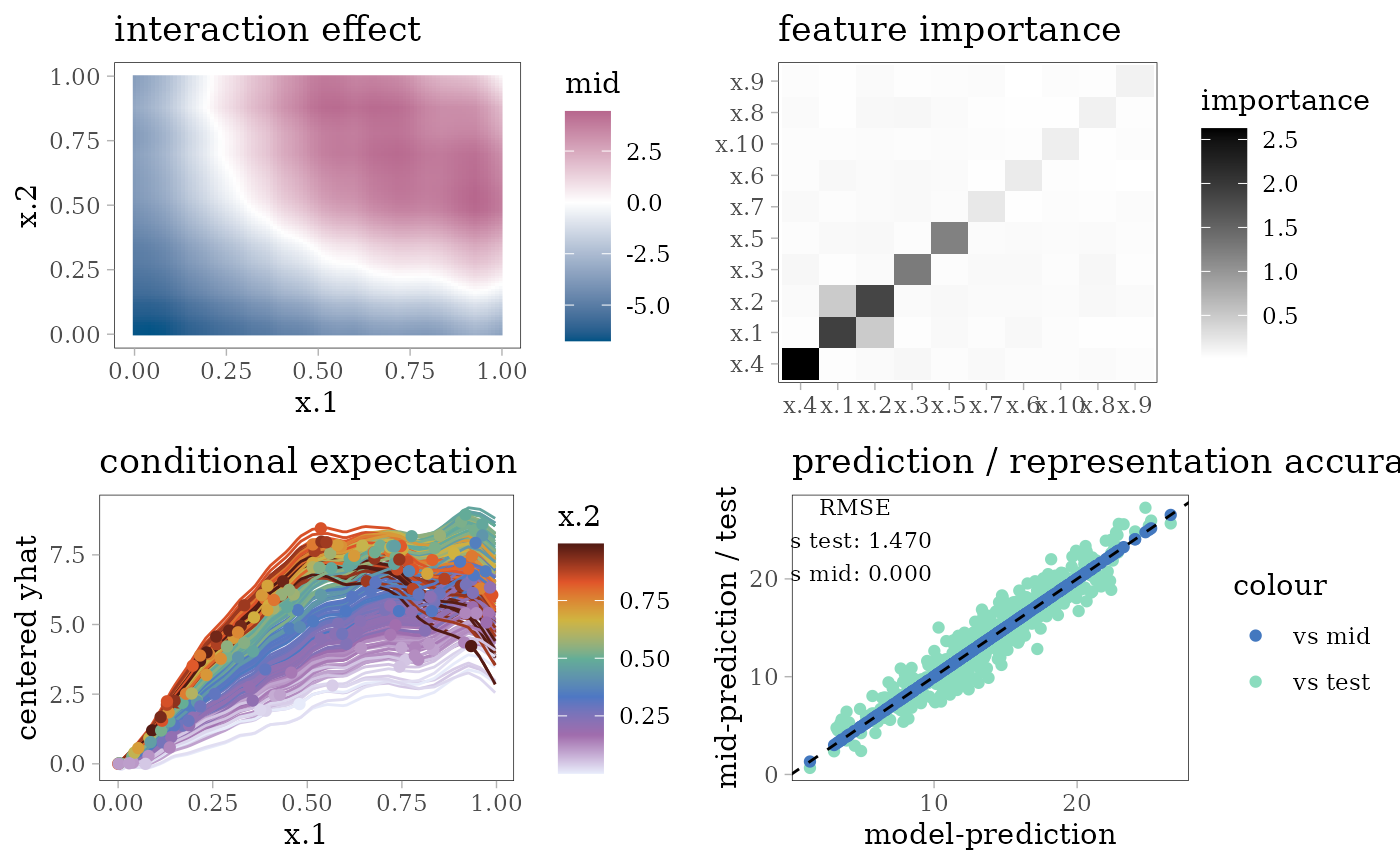This article presents some examples of the interpretation of
regression models using midr.
# load required packages
library(midr)
library(ggplot2)
library(gridExtra)
library(patchwork)
library(Metrics)
theme_set(theme_midr())Regression Task
We use a benchmark regression task, originally described in Friedman
(1991) and Breiman (1996), and implemented in the mlbench
package. The dataset has 10 independent predictor variables
each uniformly distributed on the interval
,
and the response variable
, generated according to the following formula with disturbance term
.
The following plots show the effect of each predictor variable on the response. For and , the interaction effect is shown by the colored lines: the effect of depends on the value of (pale purple for 0 and dark red for 1) and vice versa.
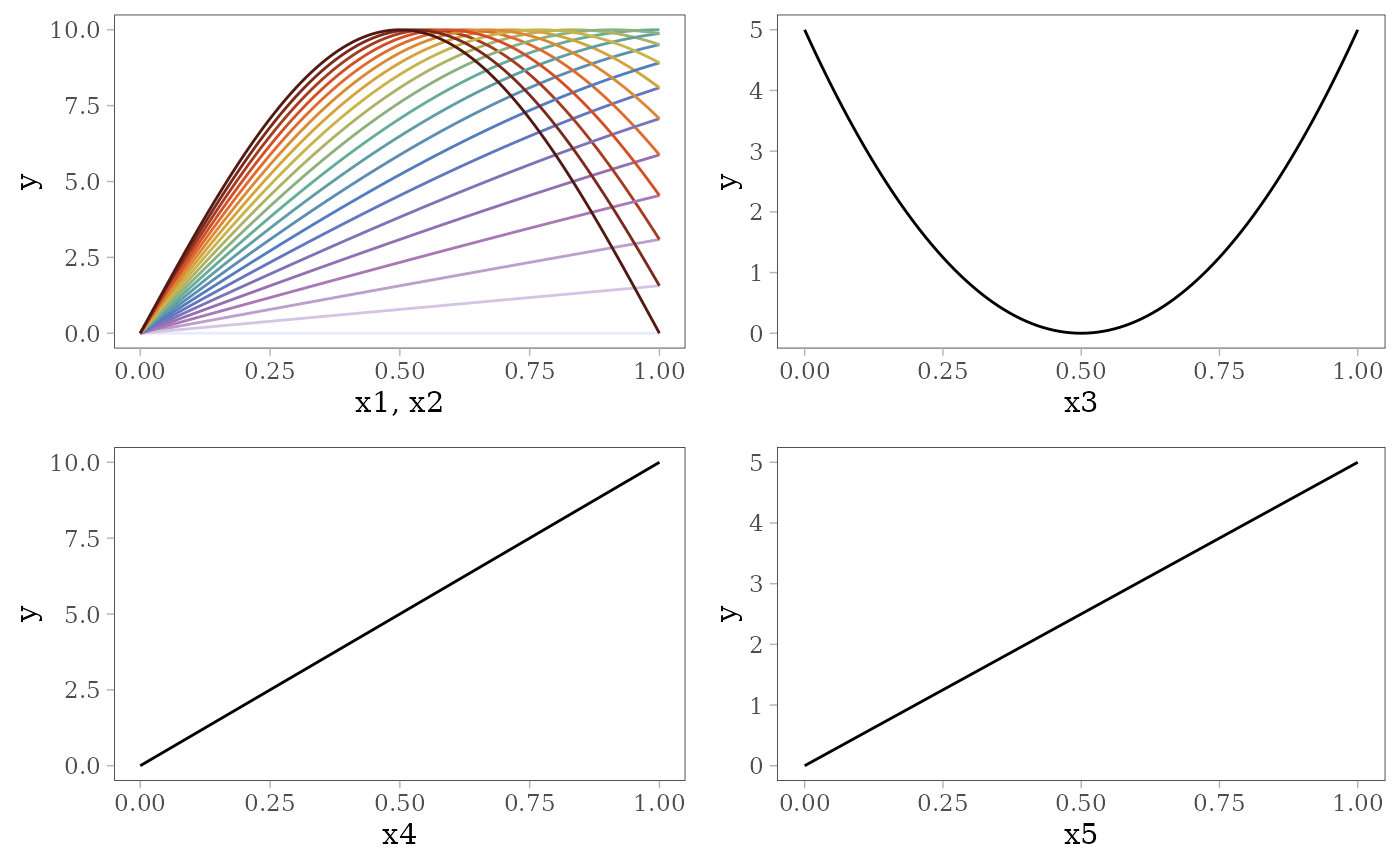
# benchmark regression task
library(mlbench)
set.seed(42)
train <- as.data.frame(mlbench.friedman1(n = 500L))
test <- as.data.frame(mlbench.friedman1(n = 500L))
mtrain <- as.data.frame(mlbench.friedman1(n = 2500L))[, -11L]For each model type, we fit a regression model using the
train data of 500 observations and an interpretative MID
surrogate of the target model using the mtrain data of 2500
observations without the response variable. We then evaluate the
predictive accuracy of the target model and the interpretative accuracy
of the MID surrogate based on the RMSE between the test and
model prediction or the two predictions, respectively.
# define utility functions for the following chunks
effect_plots <- function(object) {
mid.plots(object, terms = paste("x", 1:6, sep = "."))
}
interaction_plot <- function(object) {
ggmid(object, "x.1:x.2", main.effects = TRUE, theme = "Zissou 1") +
ggtitle("interaction effect")
}
ice_theme <- color.theme("Zissou 1@seq")
ice_plot <- function(object, data = train[1:200, ]) {
ggmid(mid.conditional(object, "x.1", data = data),
var.color = x.2, type = "centered", theme = ice_theme) +
ggtitle("conditional expectation")
}
importance_plot <- function(object) {
ggmid(mid.importance(object), "heatmap") +
ggtitle("feature importance")
}
eval_plot <- function(model, mid, data = test, ...) {
pred <- get.yhat(model, data, ...)
pred_mid <- get.yhat(mid, data)
actual <- test$y
rmse_vs_test <- rmse(pred, actual)
rmse_vs_mid <- rmse(pred, pred_mid)
ggplot() + scale_color_theme("highlight?accent='#F5191C'") +
geom_point(aes(x = pred, y = actual, col = "vs test")) +
geom_point(aes(x = pred, y = pred_mid, col = "vs mid")) +
geom_abline(slope = 1, intercept = 0, col = "black", lty = 2) +
labs(x = "model-prediction", y = "mid-prediction / test") +
annotate(
"text", family = "serif", size = 3,
x = min(pred) + diff(range(pred)) / 8,
y = max(actual) - diff(range(actual) / 8),
label = sprintf("RMSE\nvs test: %.3f\nvs mid: %.3f",
rmse_vs_test, rmse_vs_mid)
) + ggtitle("prediction / representation accuracy")
}Additive Models
Linear Model
model <- lm(y ~ ., train)
coef(model)
#> (Intercept) x.1 x.2 x.3 x.4 x.5
#> 0.1302510 6.8458545 6.8892805 -0.4403955 10.3264576 4.6735425
#> x.6 x.7 x.8 x.9 x.10
#> 0.5837944 0.2030152 -0.6272202 -0.1722106 0.3453933
mid <- interpret(y ~ .^2, mtrain, model)
print(mid)
#>
#> Call:
#> interpret(formula = ~.^2, data = mtrain, model = model)
#>
#> Model Class: lm
#>
#> Intercept: 14.319
#>
#> Main Effects:
#> 10 main effect terms
#>
#> Interactions:
#> 45 interaction terms
#>
#> Uninterpreted Variation Ratio: 0
grid.arrange(grobs = effect_plots(mid), nrow = 2L)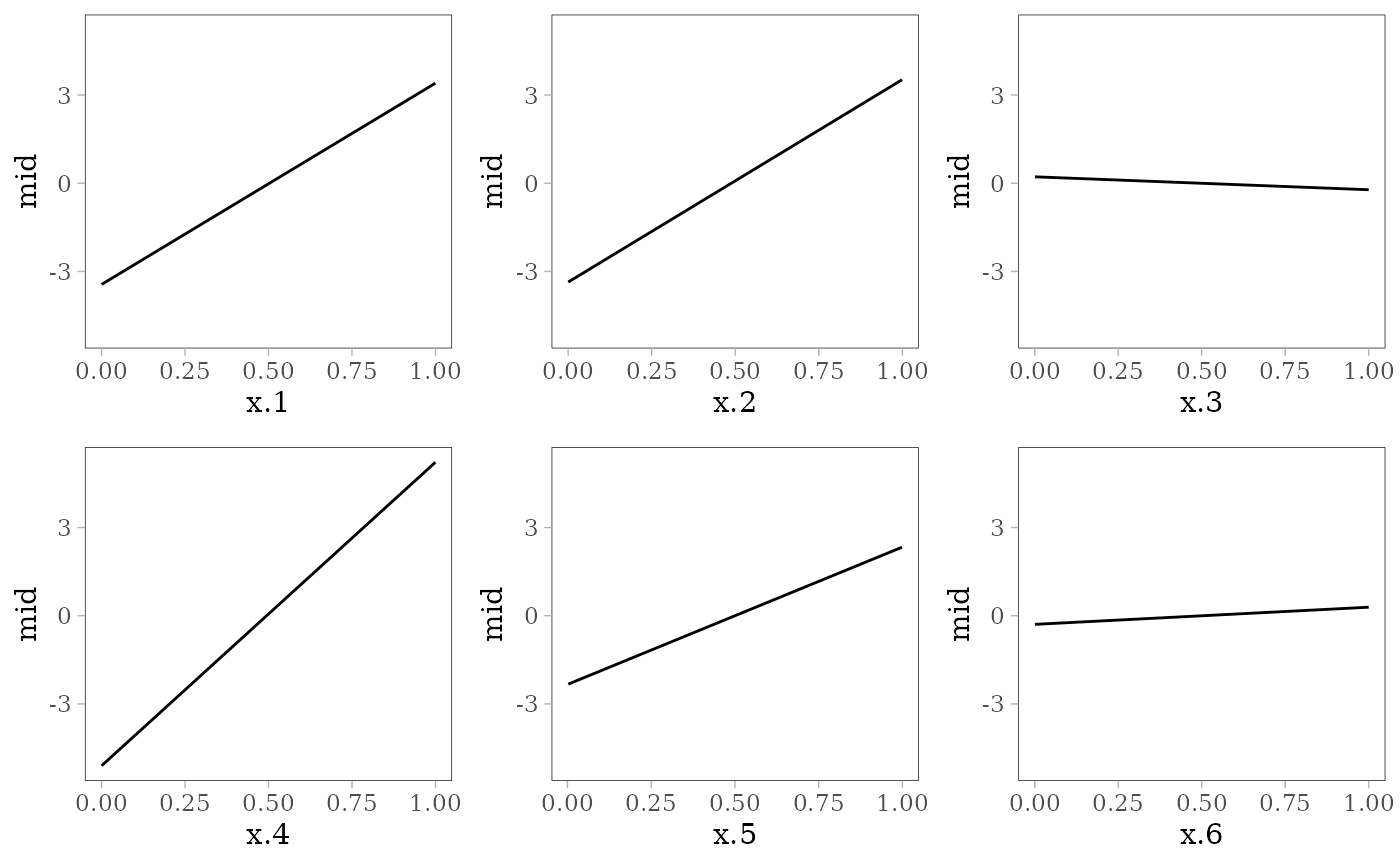
grid.arrange(interaction_plot(mid), importance_plot(mid),
ice_plot(mid), eval_plot(model, mid), nrow = 2)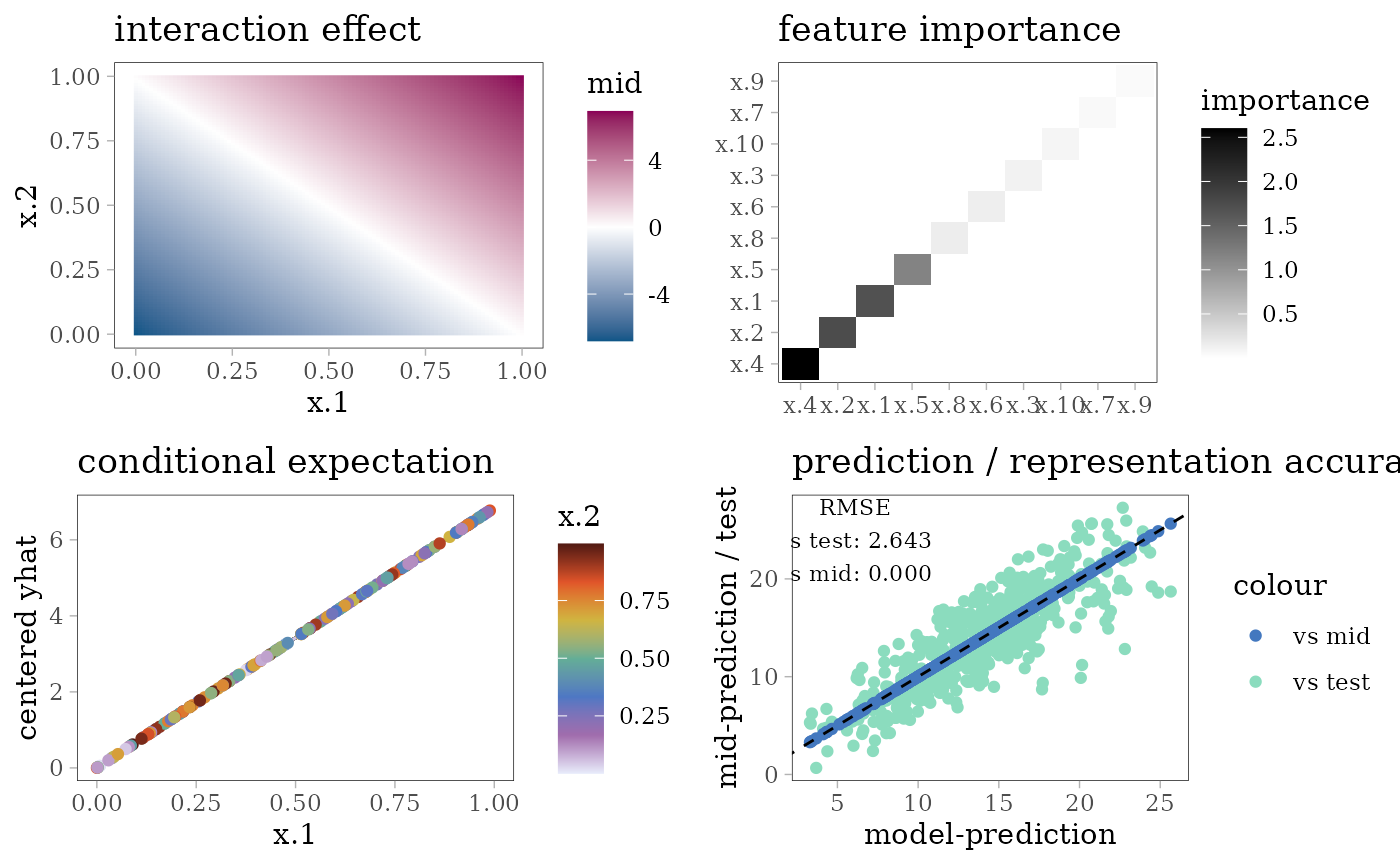
Regularized GLM
library(glmnet)
model <- glmnet(x = as.matrix(train[, -11]), y = train[, 11])
# prediction with arbitrarily chosen lambda
mid <- interpret(y ~ .^2, train[, -11], model,
pred.args = list(s = model$lambda[9]))
print(mid)
#>
#> Call:
#> interpret(formula = ~.^2, data = train[, -11], model = model,
#> pred.args = list(s = model$lambda[9]))
#>
#> Model Class: elnet, glmnet
#>
#> Intercept: 14.417
#>
#> Main Effects:
#> 10 main effect terms
#>
#> Interactions:
#> 45 interaction terms
#>
#> Uninterpreted Variation Ratio: 0
grid.arrange(grobs = effect_plots(mid), nrow = 2L)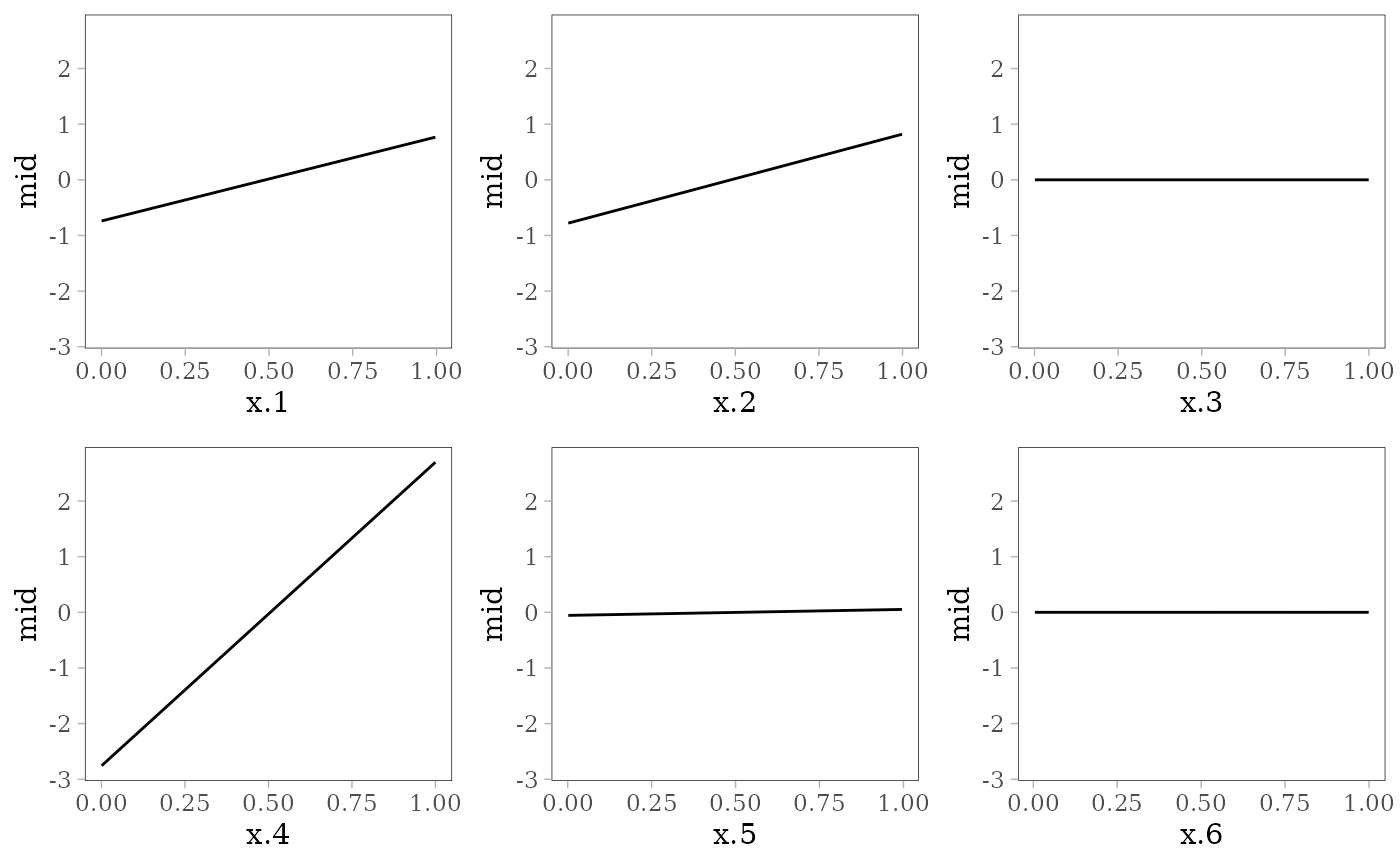
evp <- eval_plot(model, mid, data = test[, -11],
s = model$lambda[9])
grid.arrange(interaction_plot(mid), importance_plot(mid),
ice_plot(mid), evp, nrow = 2)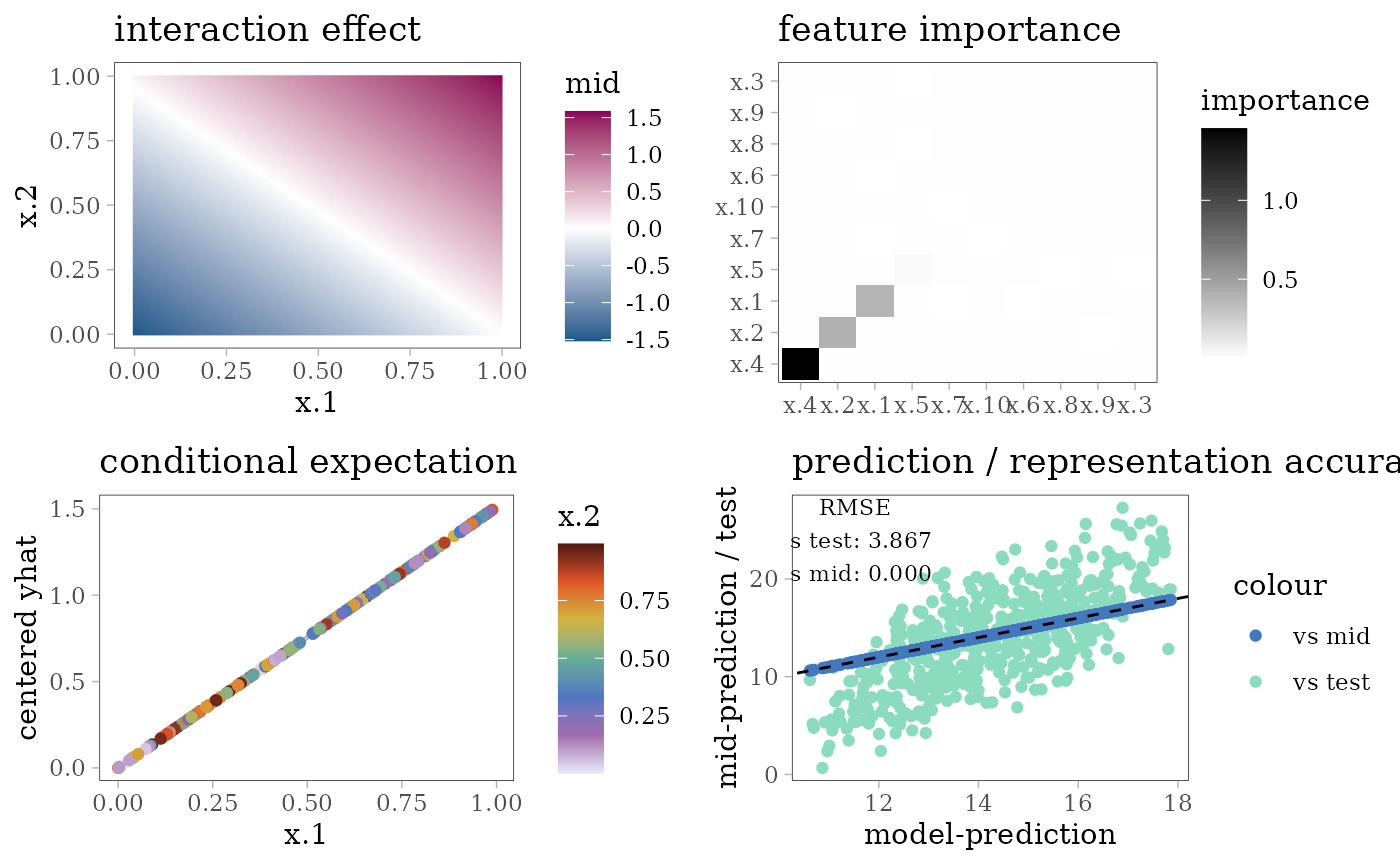
Generalized Additive Model
library(gam)
model <- gam(y ~ s(x.1) + s(x.2) + s(x.3) + s(x.4) + s(x.5) +
s(x.6) + s(x.7) + s(x.8) + s(x.9) + s(x.10),
family = gaussian, data = train)
mid <- interpret(y ~ .^2, train, model)
print(mid)
#>
#> Call:
#> interpret(formula = y ~ .^2, data = train, model = model)
#>
#> Model Class: Gam, glm, lm
#>
#> Intercept: 14.417
#>
#> Main Effects:
#> 10 main effect terms
#>
#> Interactions:
#> 45 interaction terms
#>
#> Uninterpreted Variation Ratio: 3.2805e-05
grid.arrange(grobs = effect_plots(mid), nrow = 2L)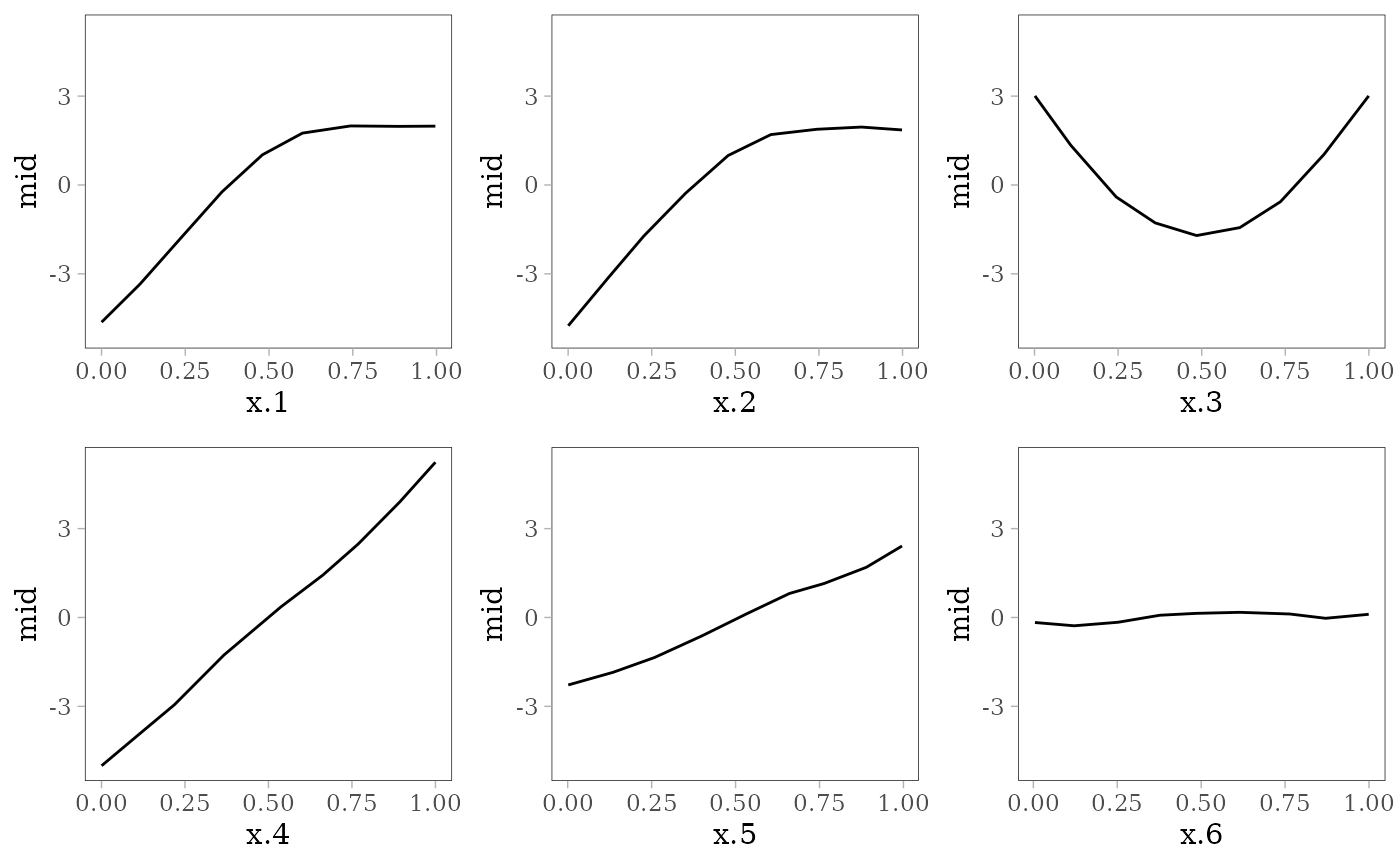
grid.arrange(interaction_plot(mid), importance_plot(mid),
ice_plot(mid), eval_plot(model, mid), nrow = 2)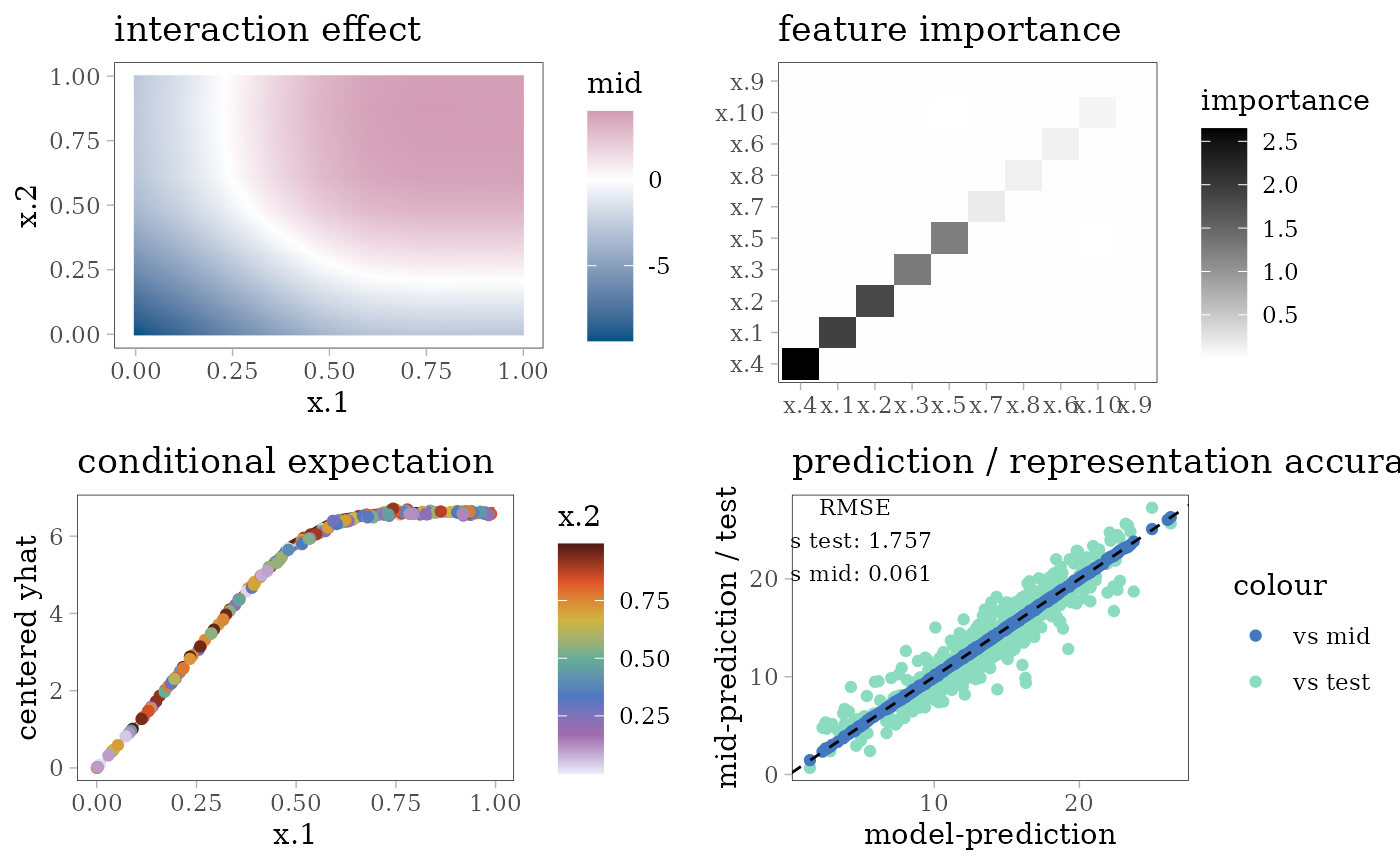
Multivariate Adaptive Regression Spline
library(earth)
model <- earth(y ~ ., degree = 2, data = train)
mid <- interpret(y ~ .^2, train, model)
print(mid)
#>
#> Call:
#> interpret(formula = y ~ .^2, data = train, model = model)
#>
#> Model Class: earth
#>
#> Intercept: 14.417
#>
#> Main Effects:
#> 10 main effect terms
#>
#> Interactions:
#> 45 interaction terms
#>
#> Uninterpreted Variation Ratio: 0.002203
grid.arrange(grobs = effect_plots(mid), nrow = 2L)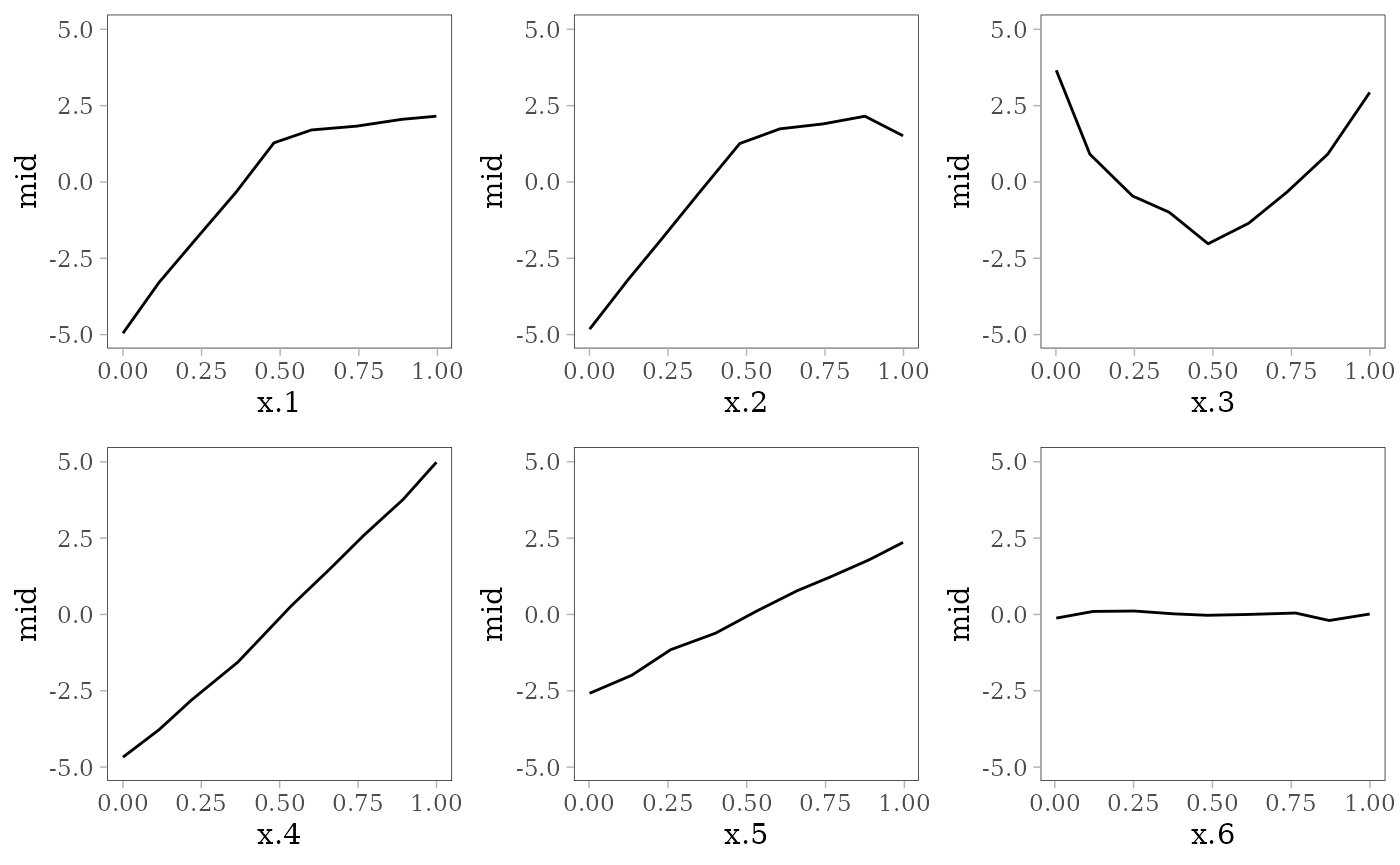
grid.arrange(interaction_plot(mid), importance_plot(mid),
ice_plot(mid), eval_plot(model, mid), nrow = 2)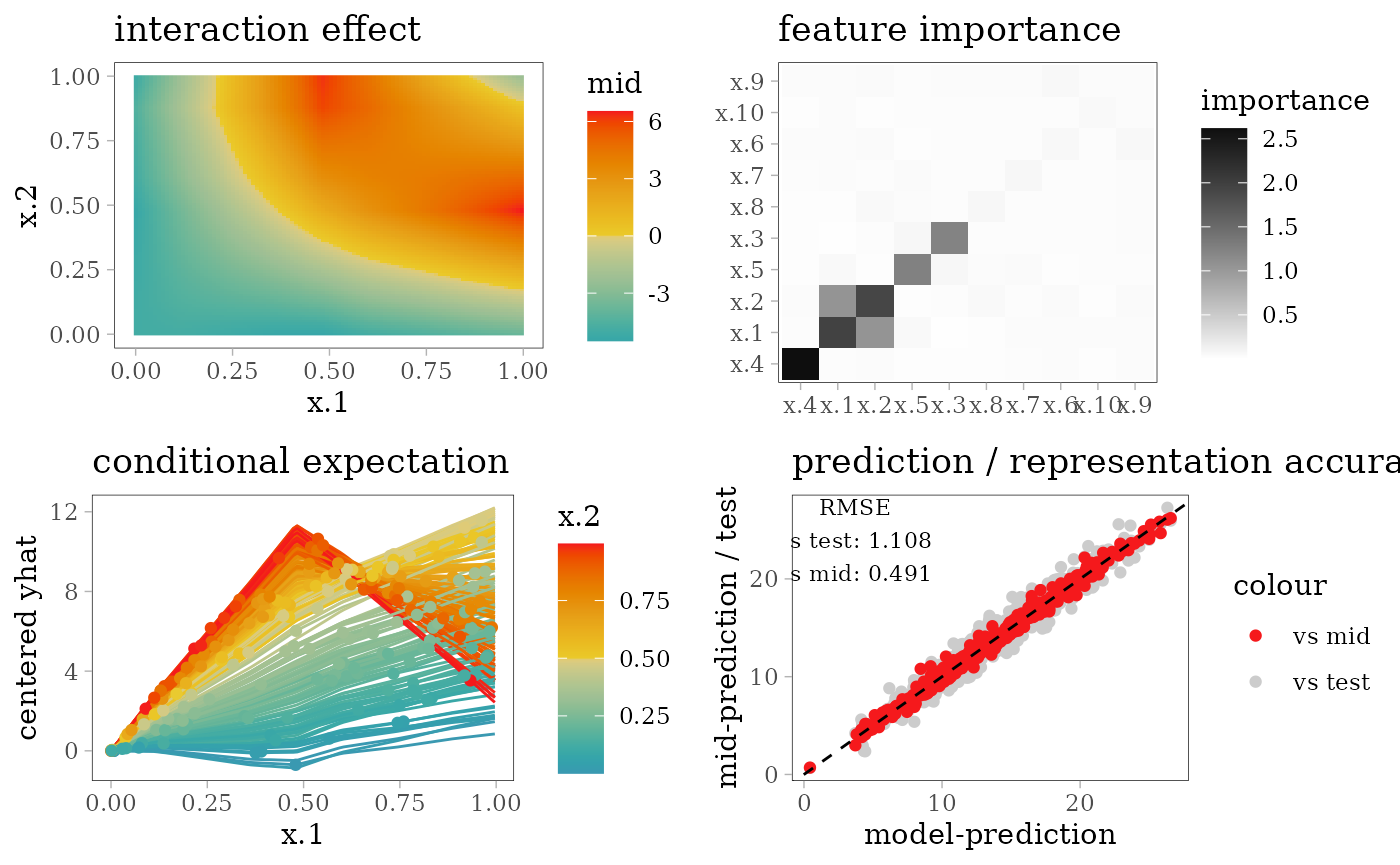
Neural Network
Single Hidden Layer Network
library(nnet)
set.seed(42)
model <- nnet(y ~ ., train, size = 5, linout = TRUE, maxit = 1e3, trace = FALSE)
mid <- interpret(y ~ .^2, mtrain, model)
print(mid)
#>
#> Call:
#> interpret(formula = ~.^2, data = mtrain, model = model)
#>
#> Model Class: nnet.formula, nnet
#>
#> Intercept: 14.195
#>
#> Main Effects:
#> 10 main effect terms
#>
#> Interactions:
#> 45 interaction terms
#>
#> Uninterpreted Variation Ratio: 0.0028096
grid.arrange(grobs = effect_plots(mid), nrow = 2L)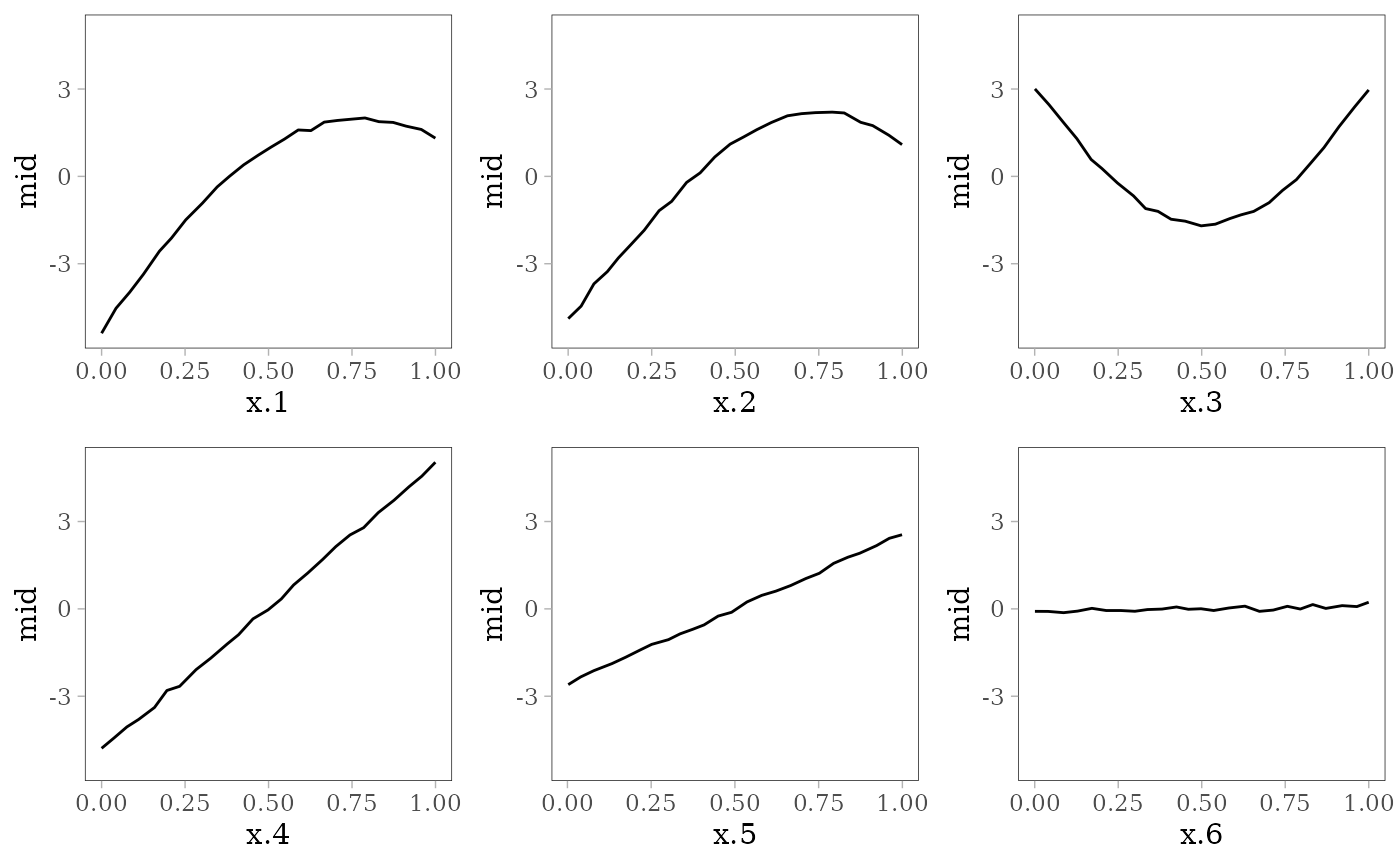
grid.arrange(interaction_plot(mid), importance_plot(mid),
ice_plot(mid), eval_plot(model, mid), nrow = 2)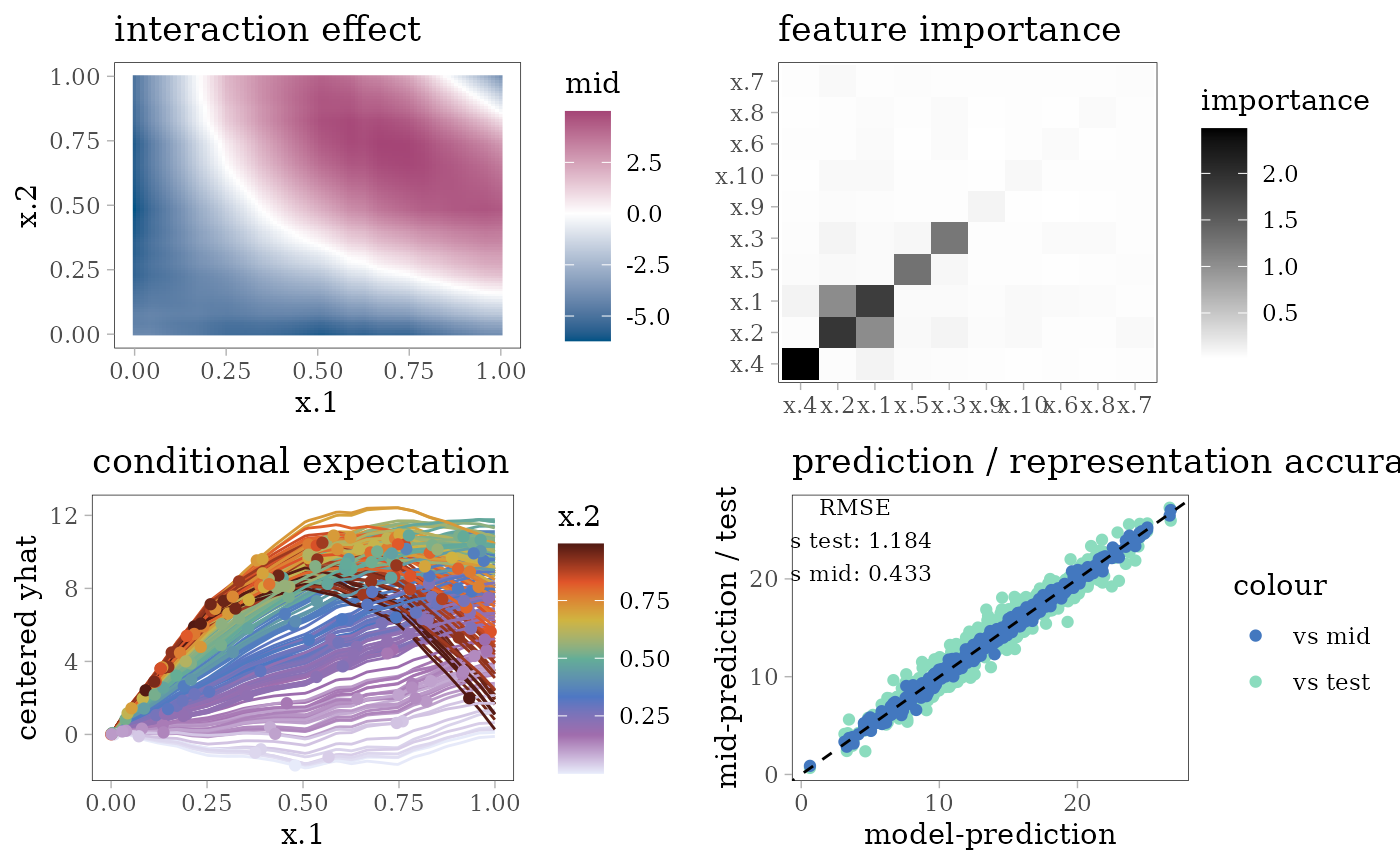
Support Vector Machine
RBF Kernel SVM
library(e1071)
#>
#> Attaching package: 'e1071'
#> The following object is masked from 'package:ggplot2':
#>
#> element
model <- svm(y ~ ., train, kernel = "radial")
mid <- interpret(y ~ .^2, mtrain, model)
print(mid)
#>
#> Call:
#> interpret(formula = ~.^2, data = mtrain, model = model)
#>
#> Model Class: svm.formula, svm
#>
#> Intercept: 14.32
#>
#> Main Effects:
#> 10 main effect terms
#>
#> Interactions:
#> 45 interaction terms
#>
#> Uninterpreted Variation Ratio: 0.0075539
grid.arrange(grobs = effect_plots(mid), nrow = 2L)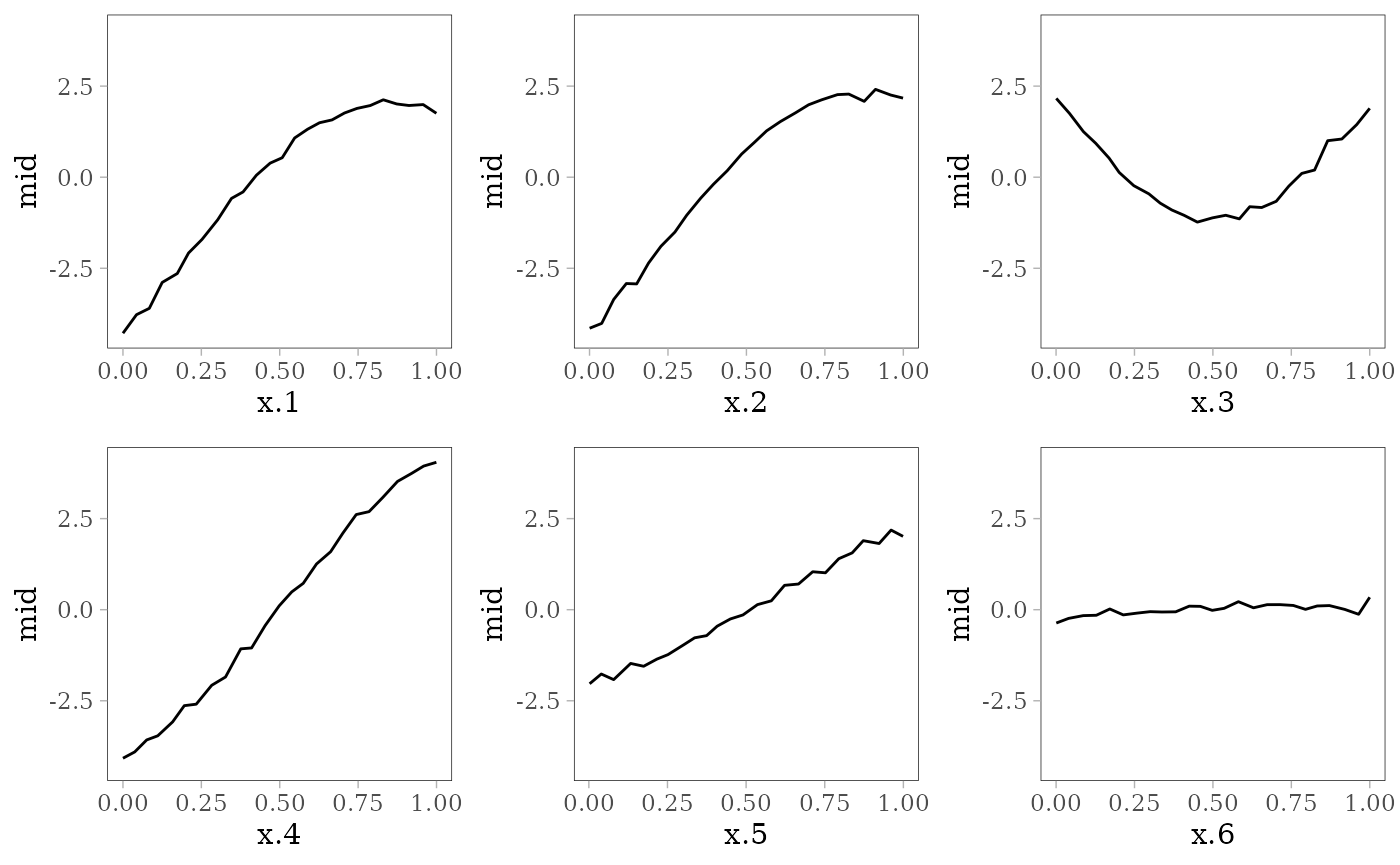
grid.arrange(interaction_plot(mid), importance_plot(mid),
ice_plot(mid), eval_plot(model, mid), nrow = 2)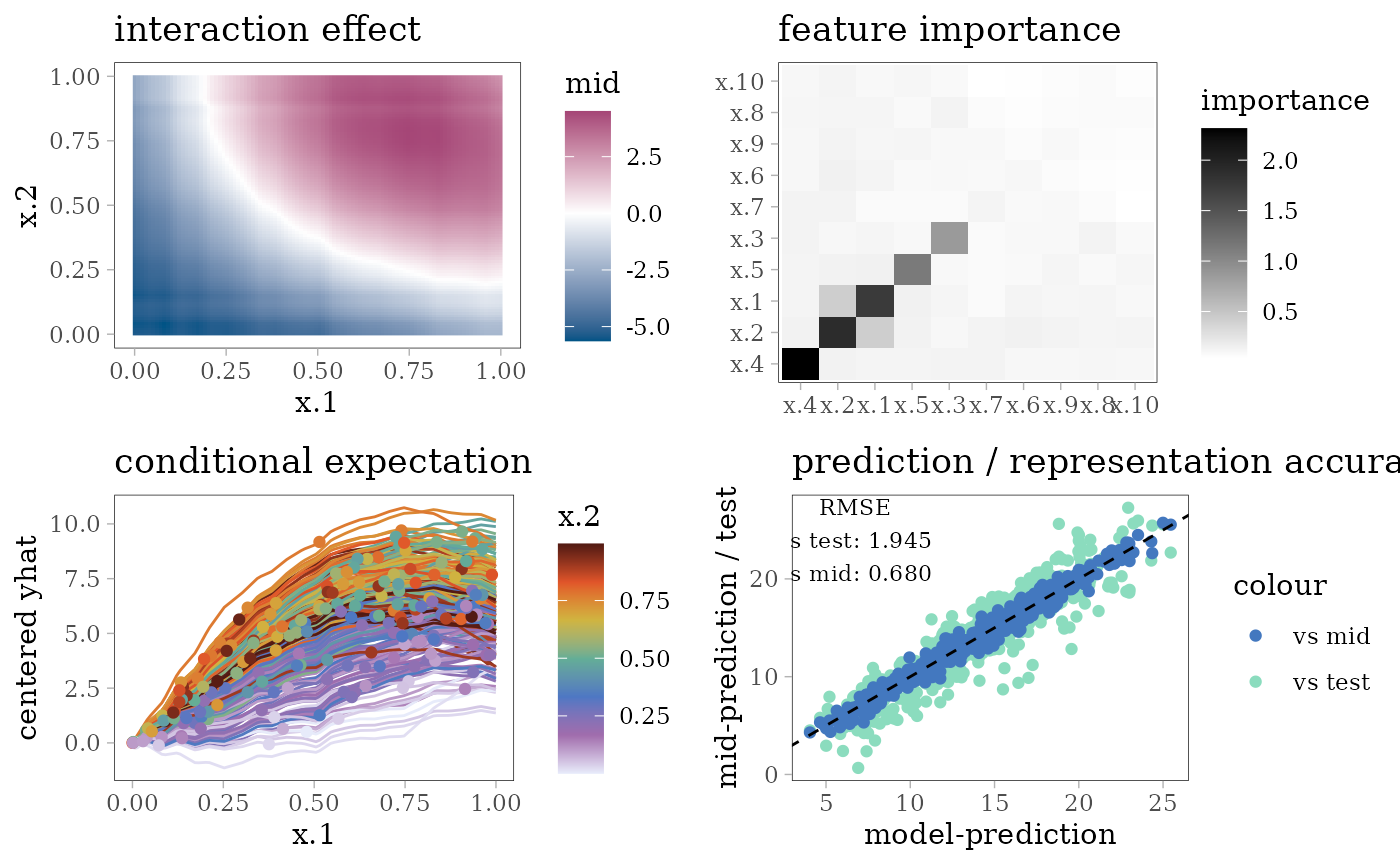
Tree Based Models
Gradient Boosting Trees
library(xgboost)
params <- list(eta = .1, subsample = .7, max_depth = 5)
set.seed(42)
model <- xgboost(as.matrix(train[, -11]), train[, 11], nrounds = 100,
params = params, verbose = 0)
mid <- interpret(y ~ .^2, as.matrix(mtrain), model)
print(mid)
#>
#> Call:
#> interpret(formula = ~.^2, data = as.matrix(mtrain), model = model)
#>
#> Model Class: xgb.Booster
#>
#> Intercept: 14.172
#>
#> Main Effects:
#> 10 main effect terms
#>
#> Interactions:
#> 45 interaction terms
#>
#> Uninterpreted Variation Ratio: 0.011813
grid.arrange(grobs = effect_plots(mid), nrow = 2L)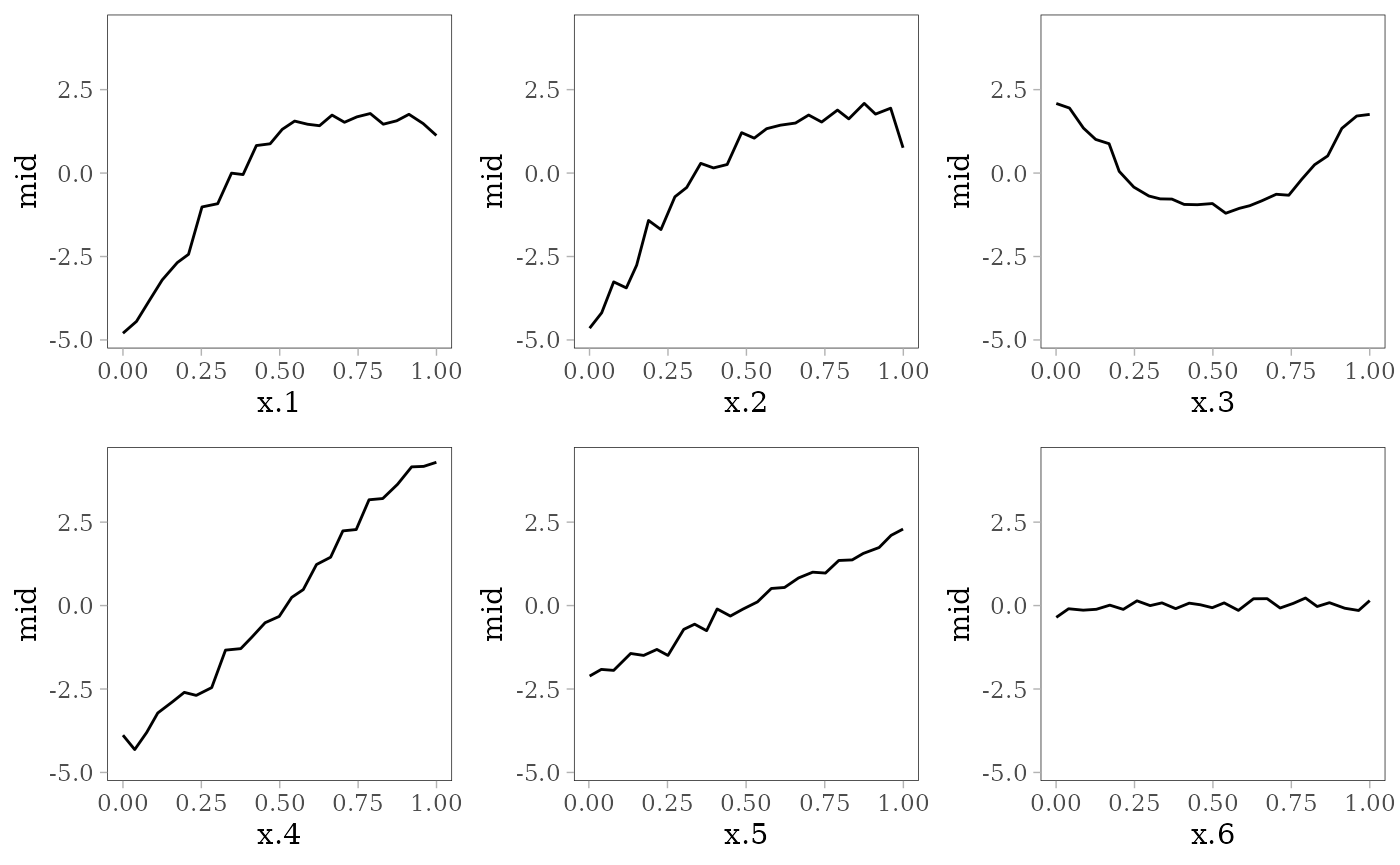
evp <- eval_plot(model, mid, as.matrix(test[, -11]))
grid.arrange(interaction_plot(mid), importance_plot(mid),
ice_plot(mid), evp, nrow = 2)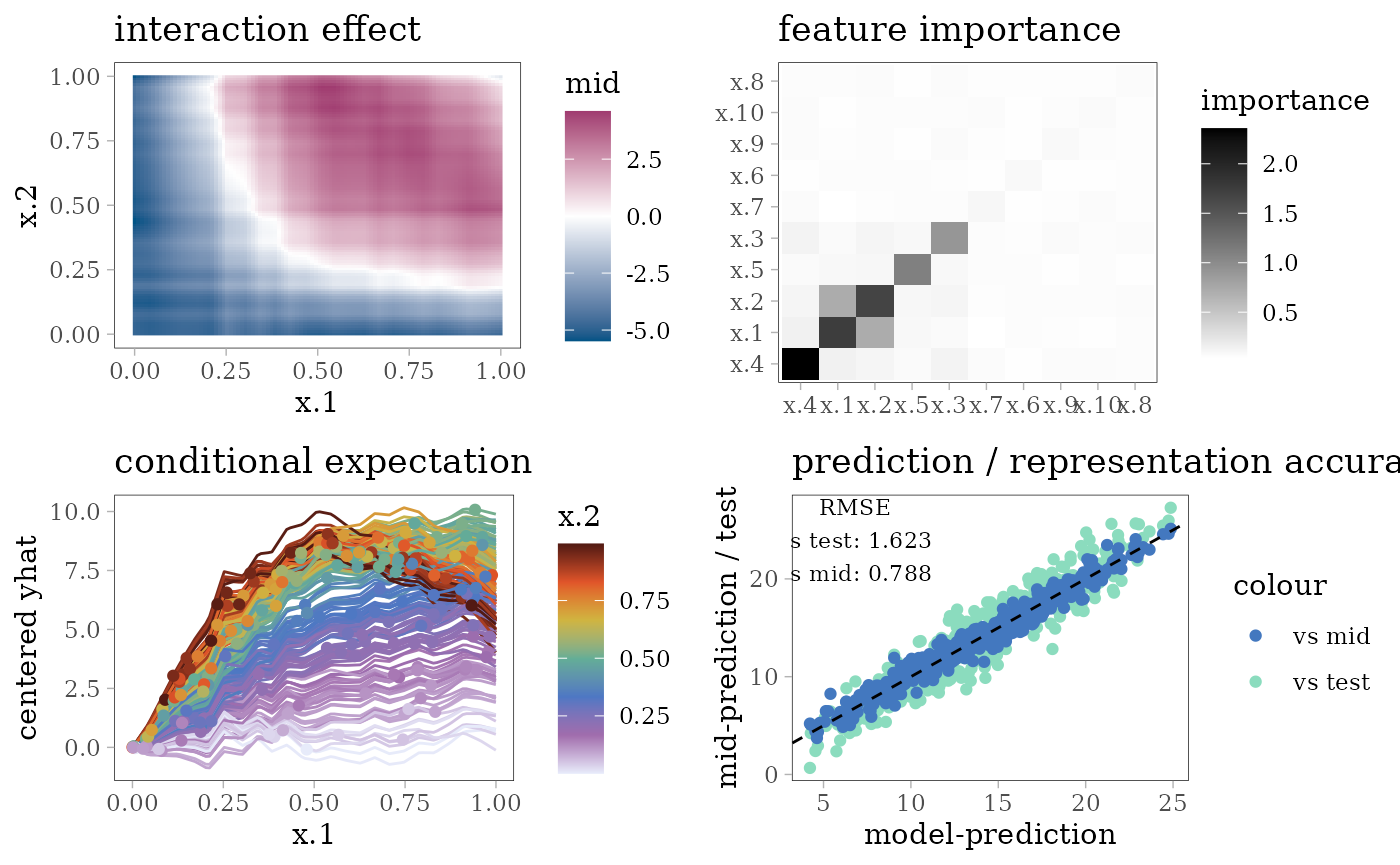
Random Forest
library(ranger)
set.seed(42)
model <- ranger(y ~ ., train, mtry = 5)
mid <- interpret(y ~ .^2, mtrain, model)
print(mid)
#>
#> Call:
#> interpret(formula = ~.^2, data = mtrain, model = model)
#>
#> Model Class: ranger
#>
#> Intercept: 14.27
#>
#> Main Effects:
#> 10 main effect terms
#>
#> Interactions:
#> 45 interaction terms
#>
#> Uninterpreted Variation Ratio: 0.0075668
grid.arrange(grobs = effect_plots(mid), nrow = 2L)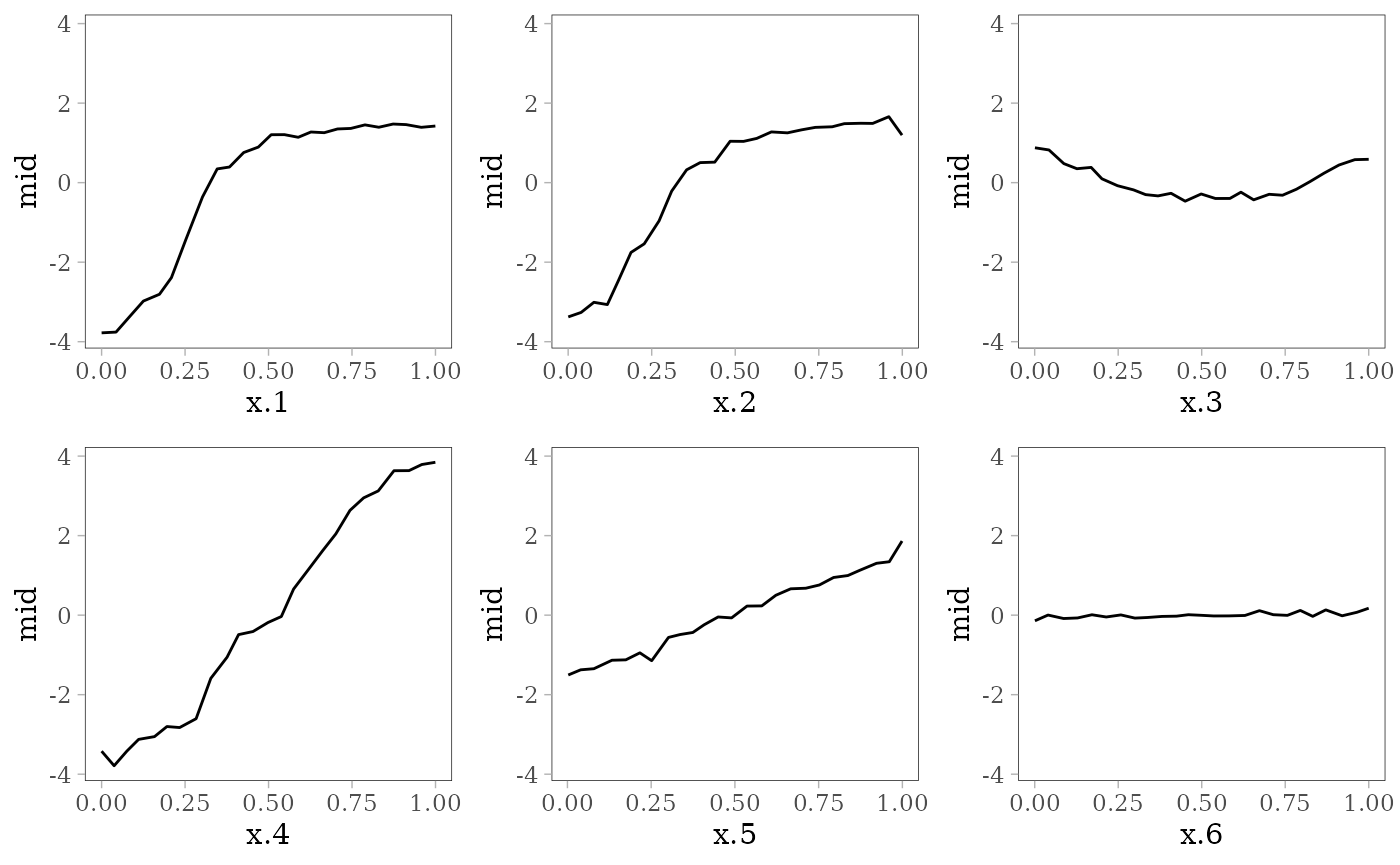
grid.arrange(interaction_plot(mid), importance_plot(mid),
ice_plot(mid), eval_plot(model, mid), nrow = 2)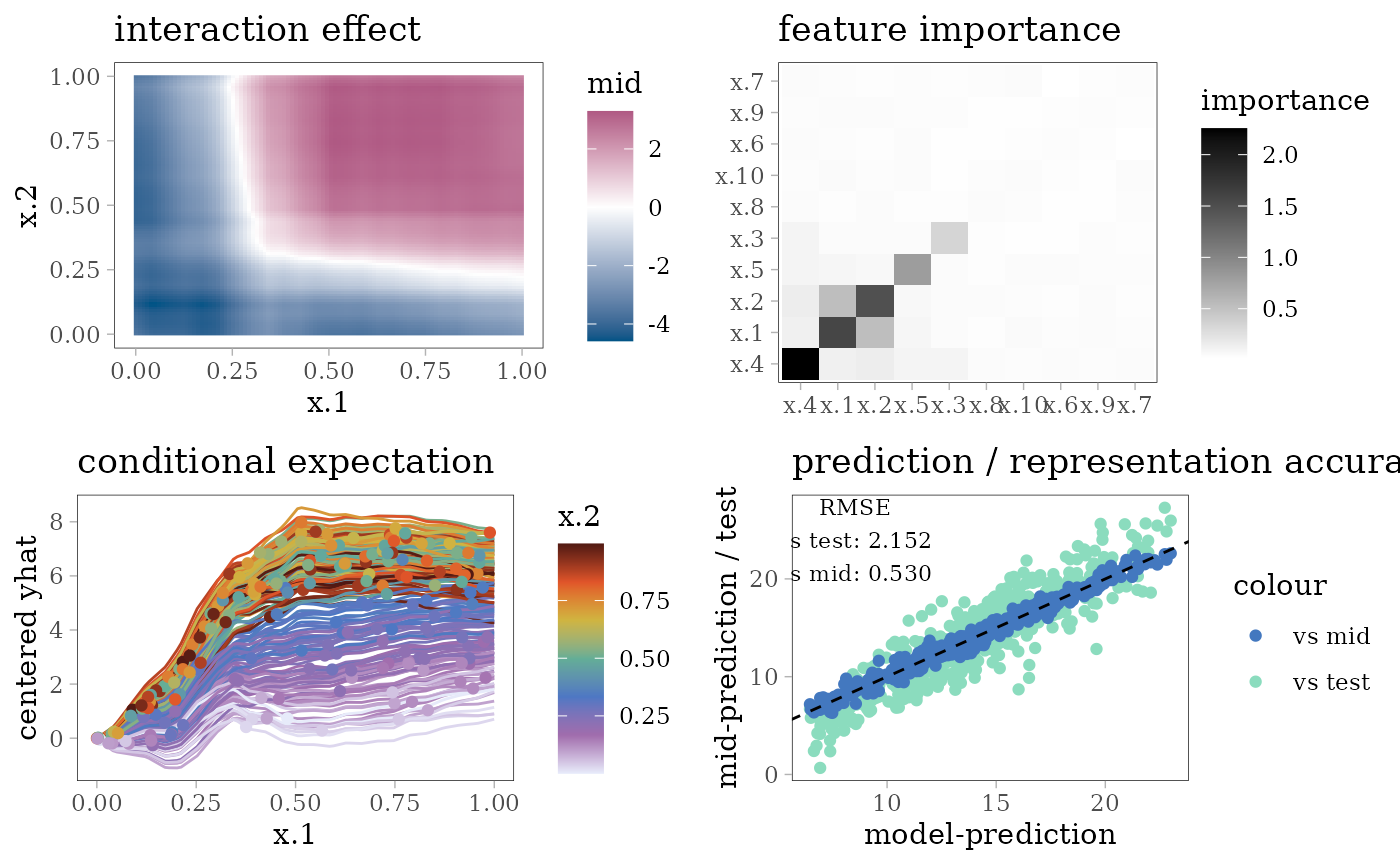
Decision Tree
library(rpart)
model <- rpart(y ~ ., train)
# create encoding frames for CART
frm <- cbind(model$frame, labels(model, collapse = FALSE))
print(t(frm[frm$var != "<leaf>", c("var", "ltemp")]))
#> 1 2 5 11 22 3 7
#> var "x.4" "x.1" "x.2" "x.4" "x.5" "x.2" "x.1"
#> ltemp "< 0.5579" "< 0.21" "< 0.311" "< 0.2953" "< 0.5849" "< 0.2653" "< 0.3184"
#> 14 15 31 62
#> var "x.4" "x.5" "x.4" "x.2"
#> ltemp "< 0.8843" "< 0.2486" "< 0.8413" "< 0.4782"
frames <- lapply(mtrain, range)
frames$x.1 <- c(frames$x.1, .2100, .3184)
frames$x.2 <- c(frames$x.2, .3110, .2653, .4782)
frames$x.4 <- c(frames$x.4, .5579, .2953, .8843, .8413)
frames$x.5 <- c(frames$x.5, .5849, .2486)
mid <- interpret(y ~ .^2, mtrain, model, type = 0, frames = frames)
print(mid)
#>
#> Call:
#> interpret(formula = ~.^2, data = mtrain, model = model, type = 0,
#> frames = frames)
#>
#> Model Class: rpart
#>
#> Intercept: 14.264
#>
#> Main Effects:
#> 10 main effect terms
#>
#> Interactions:
#> 45 interaction terms
#>
#> Uninterpreted Variation Ratio: 0.031256
grid.arrange(grobs = effect_plots(mid), nrow = 2L)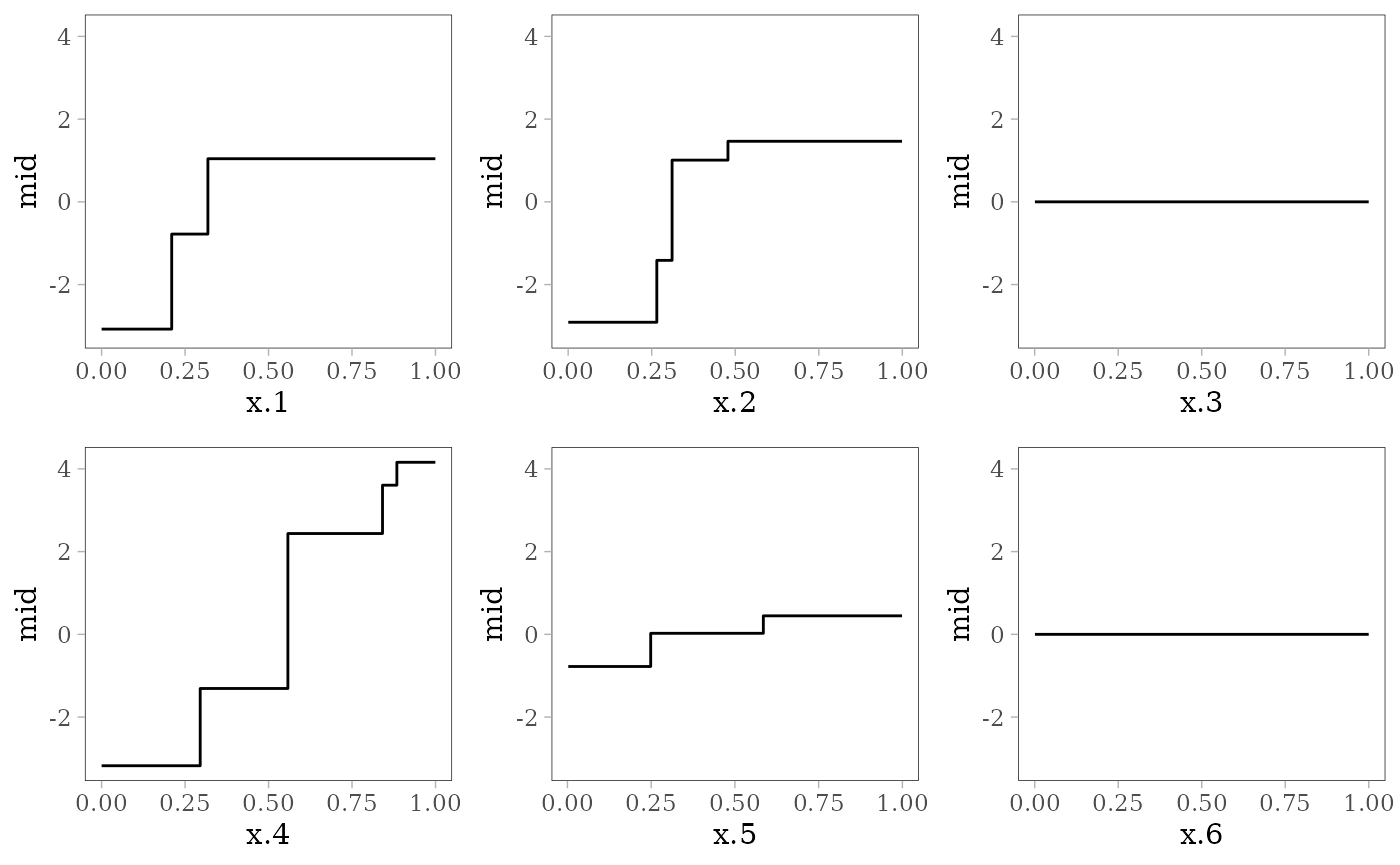
grid.arrange(interaction_plot(mid), importance_plot(mid),
ice_plot(mid), eval_plot(model, mid), nrow = 2)
Other Modes
Predictive MID
model <- mid <- interpret(y ~ .^2, train, lambda = .2)
#> 'model' not passed: response variable in 'data' is used
pred <- pred_mid <- predict(mid, test)
print(mid)
#>
#> Call:
#> interpret(formula = y ~ .^2, data = train, lambda = 0.2)
#>
#> Intercept: 14.417
#>
#> Main Effects:
#> 10 main effect terms
#>
#> Interactions:
#> 45 interaction terms
#>
#> Uninterpreted Variation Ratio: 0.031792
grid.arrange(grobs = effect_plots(mid), nrow = 2L)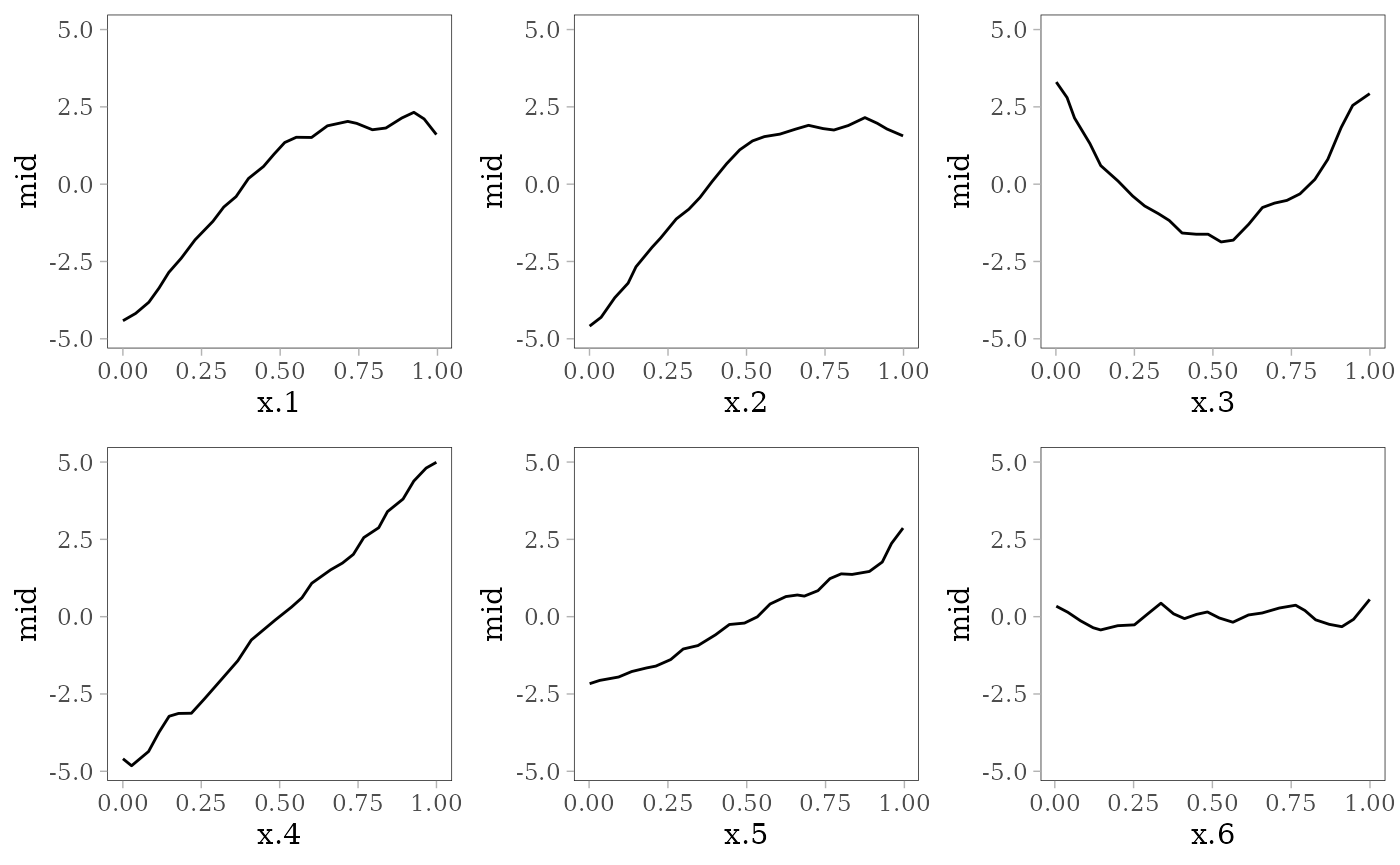
grid.arrange(interaction_plot(mid), importance_plot(mid),
ice_plot(mid), eval_plot(model, mid), nrow = 2)